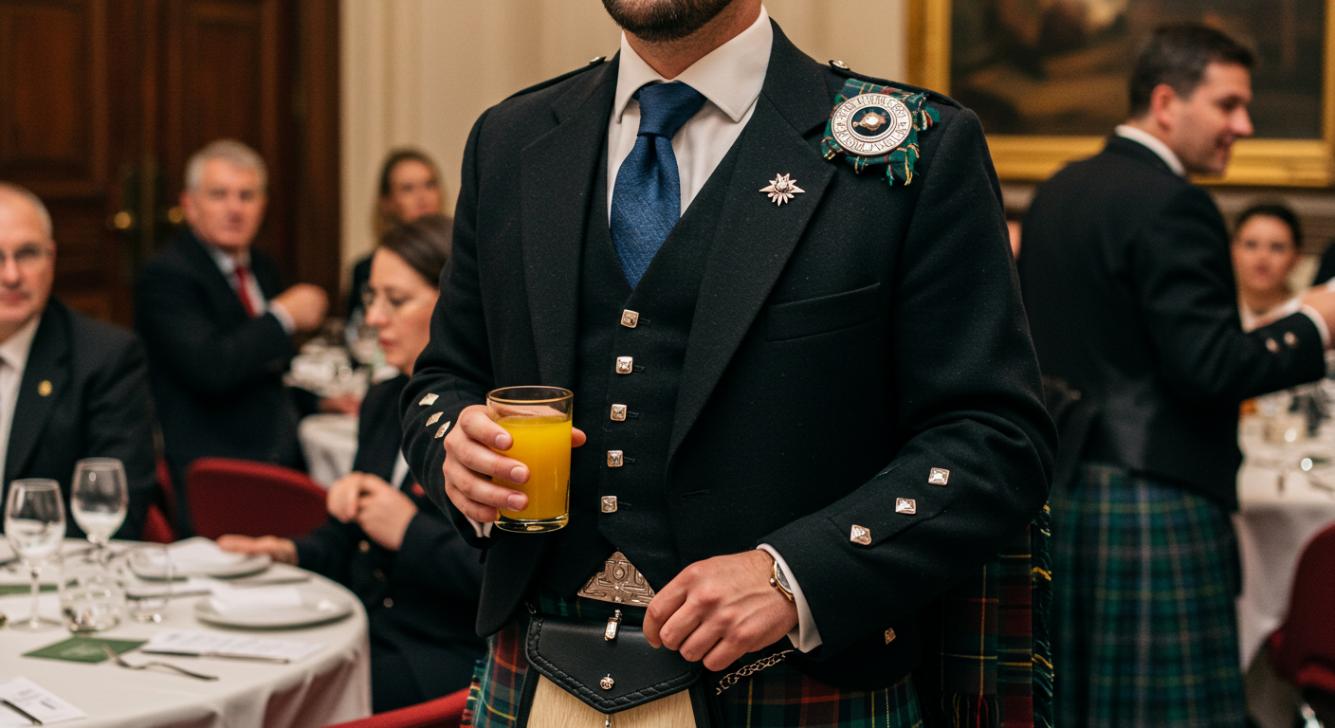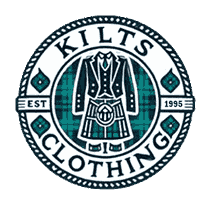Formal Kilt Etiquette: Navigating Social Norms and Expectations

Kilts, once a hallmark of Scottish tradition, have long held a revered place in formal wear. This iconic garment carries a deep sense of cultural significance from weddings to Highland gatherings. As kilts resurgence in modern fashion, understanding proper etiquette when wearing them is essential. Whether attending a wedding, gala, or cultural ceremony, wearing a kilt correctly ensures respect for tradition and personal style. In this blog, we explore the key aspects of formal kilt etiquette and the social norms that come with it.
1. Understanding the Kilt's Tradition and Symbolism
Initially designed for practicality in the rugged Scottish Highlands, the kilt has evolved into a powerful symbol of Scottish culture. Historically worn by Highland clans, the kilt represented personal and familial identity through its distinct tartan patterns. Today, it's a garment worn with pride, especially in formal settings.
When wearing a formal kilt wear, it's essential to appreciate the garment's role in honoring these traditions. The kilt isn't just a fashion item; it's a piece of heritage. A formal kilt should be treated with respect, and wearing it to a formal event requires understanding its cultural roots and the values it represents.
2. The Basics: How to Wear a Formal Kilt Correctly
The first step to mastering kilt etiquette is ensuring it is properly worn. While there are many variations of the kilt, a formal kilt typically involves several key components:
Proper Fit and Length
A formal kilt should be tailored to fit correctly. The kilt length should fall just above the knee, with the pleats flowing naturally without bunching. The waist should fit comfortably but not be too loose or tight. A too-long or short kilt can detract from its elegance and make the wearer appear unkempt.
The Kilt Jacket and Accessories
Pairing the garment with the right jacket is crucial for a kilt formal wear. The Prince Charlie jacket, often worn for weddings and formal galas, is among the most popular choices. It's traditionally worn with a white shirt, bow tie, and cufflinks, providing a sharp and refined look. Alternatively, the Argyle jacket offers a slightly more relaxed appearance while maintaining an air of formality.
Accessories like the sporran, kilt pins, and sgian dubh (a traditional Scottish knife worn in the sock) also play an important role in completing the ensemble. The sporran is essential as it serves a functional and decorative purpose, holding personal items while adhering to tradition.
Footwear
Footwear for a formal kilt should be sturdy and elegant. Brogues, especially ghillie brogues, are the traditional footwear worn with kilts. These shoes, with their long laces wrapped around the ankle, are iconic in their appearance and help complete the kilt's look. Ensuring that your footwear is polished and in good condition is essential, as it forms a part of the overall presentation.
3. The Role of the Tartan: Choosing the Right Pattern
Tartan, a distinctive pattern of crisscrossed horizontal and vertical bands, is integral to the formal kilt. The choice of tartan often carries personal or familial significance. Historically, different clans had their tartans, making the kilt not only a symbol of national pride but also a symbol of family and heritage.
When selecting a tartan for a formal kilt, it's essential to consider the occasion. Some formal events, particularly weddings, may use any tartan pattern. In contrast, others may call for specific clan tartans or more neutral options. For instance, a guest at a wedding might choose a tartan that isn't associated with a particular clan to avoid appearing too formal or competitive with the groom's family.
If you have Scottish heritage, wearing your family's tartan is a great way to honor your roots. However, suppose you do not belong to a particular clan. In that case, choosing a more generalized tartan or one that reflects your style is perfectly acceptable.
4. How to Wear a Kilt at Different Formal Events
The formal kilt can be worn on various occasions. Still, the key is understanding how it fits into the event's context. Here are some etiquette tips for wearing a kilt at different formal events:
Weddings
The groom, groomsmen, or guests with Scottish heritage most often wear kilts at weddings. If you're attending a wedding where the kilt is part of the dress code, ensure that it aligns with the level of formality requested. Often, the groom will choose a specific tartan to wear, and guests will follow suit by selecting their own or opting for a neutral choice.
The kilt can be paired with a formal jacket, bow tie, and polished shoes for men. The color of the tie and jacket should complement the wedding's theme, avoiding flashy patterns or clashing colors.
Graduations and Academic Ceremonies
Graduation ceremonies and other academic events have become increasingly popular for wearing kilts. The key here is to adhere to the academic dress code while adding the kilt as a distinguished attire. A kilt should be worn with a formal academic gown, and it's important not to stray too far from the traditional norms—think subtlety and elegance.
Cultural and National Ceremonies
Kilts are often worn at Highland Games, military ceremonies, or cultural festivals, where they carry deep national and personal meaning. In these settings, the kilt should be worn with reverence for its cultural significance, ensuring that it is worn with the appropriate accessories and accompanied by a well-maintained appearance.
Dinner Events and Galas
The kilt is a distinctive alternative to traditional tuxedos or suits for formal dinners, balls, and galas. The Prince Charlie or Argyle jacket is commonly worn in these settings, paired with a white shirt, a bow tie, and polished shoes. When wearing a kilt for an elegant dinner or gala, always ensure the kilt is neatly pressed, and the accessories are in good condition.
5. Gender Considerations in Formal Kilt Etiquette
While the kilt has historically been associated with men's fashion, women increasingly embrace the garment in formal settings. Regarding formal kilt etiquette, the general rules apply to both genders, with some differences in styling.
Traditional Men's Kilts
For men, the traditional kilt is worn with customary accessories such as the sporran, sgian dubh, and kilt hose. The look is typically masculine, but it is always polished and elegant. Men must ensure their kilt is worn correctly, with attention paid to fit and accessories.
Women's Kilts and Gender Fluidity
More women choose kilts as formal attire, especially for weddings or themed parties. Women's kilts are often styled slightly differently, sometimes incorporating skirts or dresses. However, the overall principles of formal kilt etiquette still apply. When wearing a kilt as a woman, it's essential to ensure that it fits well and complements the rest of the outfit, whether paired with a tailored jacket or blouse.
Unisex and Hybrid Styles
In recent years, unisex kilts and hybrid styles have emerged, allowing for greater diversity in how kilts are worn. These hybrid designs mix traditional and modern elements, offering more options for both men and women. Regardless of the style chosen, the general etiquette surrounding the proper fit and respect for tradition remains the same.
6. Grooming and Presentation: A Polished Look
A key aspect of kilt etiquette is presentation. Kilts are designed to look sharp but require proper grooming and care to maintain their formality. Ensure your hair is neat, your shoes are polished, and your accessories (such as the sporran) are pristine. The goal is to present a polished, well-put-together look that reflects the respect and reverence that the kilt deserves.
7. Avoiding Fashion Faux Pas
Finally, here are a few common mistakes to avoid when wearing a kilt. These include wearing the kilt too short or too long, using inappropriate footwear (sneakers or casual shoes), or neglecting to wear the correct accessories. Additionally, it's crucial not to wear a kilt with overly casual attire, diminishing its formal impact.
Conclusion: Mastering Formal Kilt Etiquette for Every Event
Wearing a formal kilt expresses both cultural pride and sophisticated style. Understanding the garment's etiquette is key to wearing it respectfully and gracefully. Whether attending a wedding, gala, or cultural event, adhering to the traditional norms of kilt etiquette ensures that you look your best and honor the centuries-old heritage behind this iconic piece of clothing. By paying attention to the details, choosing the right accessories, and understanding the cultural context, you can confidently wear your formal kilt and carry its legacy in modern times.


